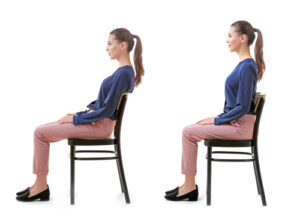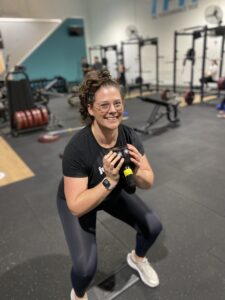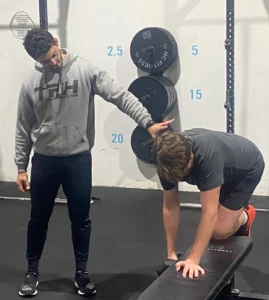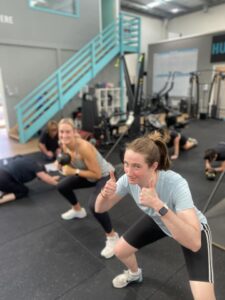As a personal trainer and owner of The Performance Hub, I’ve seen countless individuals over 40 struggle with poor posture. It’s a common issue that can lead to discomfort, reduced mobility, and even long-term health problems. But here’s the good news: strength training can be a game-changer when it comes to improving your posture. In this comprehensive guide, we’ll explore how incorporating resistance exercises into your routine can help you stand taller, feel stronger, and move with greater ease.

Let’s face it, many of us spend our days hunched over desks, staring at screens, or slouching on the sofa. It’s no wonder our posture suffers! But before you resign yourself to a lifetime of rounded shoulders and an aching back, let me share a secret: strength training can be your ticket to better posture and a more confident you.
Now, I know what you might be thinking. “Strength training? Isn’t that just for bodybuilders and athletes?” Not at all! In fact, resistance exercises can benefit people of all ages and fitness levels, especially those of us in the over-40 club. So, whether you’re a fitness novice or a seasoned gym-goer, this guide will show you how to harness the power of strength training to improve your posture and overall well-being.
Throughout this article, we’ll delve into the science behind posture, explore the benefits of strength training, and provide you with practical exercises and tips to help you achieve better alignment. We’ll also address common concerns and misconceptions, ensuring you have all the information you need to embark on your journey to better posture.
So, are you ready to stand tall and feel great? Let’s dive in and discover how strength training can transform your posture and your life!
Understanding Posture: More Than Just Standing Straight
When we think about posture, most of us imagine a stern schoolteacher telling us to “sit up straight!” But posture is so much more than just looking prim and proper. It’s about how our bodies align and support themselves throughout the day, whether we’re standing, sitting, or moving.

The Anatomy of Good Posture
Good posture isn’t just about keeping your spine straight. It involves a complex interplay of muscles, bones, and connective tissues working together to maintain proper alignment. When you have good posture, your body is balanced and efficient, with minimal strain on your muscles and joints.
Picture this: your head is centered over your shoulders, your shoulders are relaxed and pulled back slightly, your chest is open, and your pelvis is in a neutral position. Your weight is evenly distributed between both feet, and your knees are soft, not locked. This alignment allows your body to function optimally, reducing wear and tear on your joints and minimising the risk of pain and injury.
The Consequences of Poor Posture
Now, let’s talk about what happens when our posture goes awry. Poor posture can lead to a host of issues, from minor discomfort to chronic pain. When we slouch or hunch, we put unnecessary stress on certain muscles and joints while underutilising others. This imbalance can result in:
- Neck and back pain
- Shoulder tension and rounded shoulders
- Reduced lung capacity and shallow breathing
- Digestive issues
- Headaches
- Decreased energy and mood
But it’s not just about physical discomfort. Poor posture can also affect our confidence and how others perceive us. Studies have shown that good posture is associated with increased self-esteem and a more positive outlook.
The Role of Modern Lifestyle in Posture Problems
Let’s face it: our modern lifestyle isn’t doing our posture any favours. Many of us spend hours each day sitting at desks, hunched over computers, or slouching on the sofa while binge-watching our favourite shows. Even our beloved smartphones contribute to what’s now known as “text neck” – that forward head posture we adopt when we’re glued to our screens.

Add to this a sedentary lifestyle, lack of regular exercise, and the natural effects of aging, and it’s no wonder so many of us struggle with poor posture. But don’t despair! This is where strength training comes in as a powerful tool to combat these postural challenges.
Assessing Your Current Posture
Before we dive into how strength training can help, it’s important to understand your starting point. Here’s a simple way to assess your posture:
- Stand with your back against a wall, with your heels about 6 inches away from the wall.
- Your buttocks, shoulder blades, and the back of your head should all be touching the wall.
- There should be a small space between your lower back and the wall, about the thickness of your hand.
If you find it difficult to maintain this position or notice significant gaps or asymmetries, it might indicate areas of your posture that need attention.
Remember, perfect posture doesn’t exist, and everyone’s body is unique. The goal is to work towards a posture that allows your body to function optimally and comfortably. In the next section, we’ll explore how strength training can help you achieve this goal.
The Science Behind Strength Training and Posture
Now that we’ve got a clear picture of what good posture looks like and why it matters, let’s dive into the fascinating science behind how strength training can help improve it. As a personal trainer, I’ve seen firsthand the transformative effects of resistance exercises on posture, but don’t just take my word for it – let’s look at what the research says.

Muscle Imbalances and Posture
One of the key ways strength training benefits posture is by addressing muscle imbalances. In our day-to-day lives, we often overuse certain muscles while neglecting others. For example, if you spend a lot of time sitting at a desk, you might develop tight chest muscles and weak upper back muscles. This imbalance can pull your shoulders forward, leading to that all-too-common rounded shoulder posture.
Strength training allows us to target and strengthen specific muscle groups, helping to correct these imbalances. By strengthening the muscles that support good posture – such as the core, back, and glutes – we can create a more balanced and aligned body.
Neuromuscular Adaptations
When we engage in strength training, we’re not just building muscle – we’re also training our nervous system. This process, known as neuromuscular adaptation, involves improving the communication between our brain and our muscles.
As we practice exercises with good form, our brain learns to recruit the right muscles at the right time to maintain proper alignment. Over time, this can lead to improved posture even when we’re not actively thinking about it. It’s like reprogramming your body’s default settings!
Bone Density and Posture
Strength training doesn’t just benefit our muscles – it’s also great for our bones. As we age, we naturally lose bone density, which can lead to a stooped posture and increased risk of fractures. However, resistance exercises have been shown to help maintain and even increase bone density, particularly in weight-bearing areas like the spine and hips.
By keeping our bones strong, we’re better able to maintain good posture and reduce the risk of postural issues related to conditions like osteoporosis.
Hormonal Benefits
Believe it or not, strength training can also influence our hormones in ways that benefit our posture. Regular resistance exercise has been shown to increase levels of growth hormone and testosterone (yes, even in women, albeit in smaller amounts). These hormones play crucial roles in muscle growth and repair, as well as bone health.
Additionally, strength training can help reduce levels of cortisol, the stress hormone. High cortisol levels are associated with muscle breakdown and can contribute to poor posture by weakening the muscles that support our spine.
Improved Body Awareness
One often overlooked benefit of strength training is its ability to improve proprioception – our sense of where our body is in space. As we perform various exercises, we become more attuned to our body’s position and movement.
This increased body awareness can translate to better posture throughout the day. You might find yourself naturally sitting up straighter or catching yourself when you start to slouch. It’s like developing an internal posture coach!

The Mind-Body Connection
Finally, let’s not forget the psychological benefits of strength training. Regular exercise has been shown to reduce stress, improve mood, and boost confidence – all of which can positively impact our posture.
When we feel strong and confident, we’re more likely to stand tall and take up space. This “power posing” can create a positive feedback loop, further reinforcing good posture and its associated benefits.
As you can see, the science behind strength training and posture is multifaceted and compelling. By engaging in regular resistance exercises, we’re not just building stronger muscles – we’re creating a foundation for better alignment, improved body awareness, and overall health.
In the next section, we’ll explore specific exercises that can help you harness these benefits and start improving your posture today. Remember, it’s never too late to start reaping the rewards of strength training!
Essential Strength Training Exercises for Better Posture
Now that we understand the science behind how strength training can improve posture, let’s get practical. In this section, I’ll share some of my favourite exercises that target key muscle groups for better posture. Remember, consistency is key – aim to incorporate these exercises into your routine 2-3 times a week for best results.
Core Strengthening Exercises
A strong core is essential for good posture. It helps stabilize your spine and supports your entire body. Here are some effective core exercises:
- Planks: The classic plank is a fantastic exercise for overall core strength. Start with 30 seconds and gradually increase your hold time.
- Dead Bug: Lie on your back, arms extended towards the ceiling, and legs in a tabletop position. Slowly lower opposite arm and leg, then return to start. Repeat on the other side.
- Bird Dog: On all fours, extend opposite arm and leg, hold for a few seconds, then return to start. This exercise improves core stability and balance.

Upper Back and Shoulder Exercises
These exercises target the muscles that help pull your shoulders back and down, counteracting the forward slouch many of us develop:
- Rows: Using dumbbells or a resistance band, perform bent-over rows to strengthen your upper back muscles.
- Face Pulls: Using a cable machine or resistance band, pull the band towards your face, focusing on squeezing your shoulder blades together.
- Wall Angels: Stand with your back against a wall and perform a snow angel motion with your arms. This helps improve shoulder mobility and posture awareness.
Lower Body and Hip Exercises
Strong glutes and legs provide a solid foundation for good posture:
- Squats: Focus on keeping your chest up and core engaged throughout the movement.
- Glute Bridges: Lie on your back with knees bent, then lift your hips towards the ceiling, squeezing your glutes at the top.
- Lunges: Perform forward, reverse, or walking lunges to strengthen your legs and improve balance.
Chest Opening Exercises
These exercises help counteract the rounded shoulder posture many of us develop:
- Chest Stretch: Stand in a doorway with your arms on either side of the frame, then lean forward to feel a stretch across your chest.
- Resistance Band Pull-Aparts: Hold a resistance band in front of you with straight arms, then pull it apart, focusing on squeezing your shoulder blades together.
Full-Body Compound Exercises
These exercises engage multiple muscle groups simultaneously, providing a comprehensive posture workout:
- Deadlifts: Focus on maintaining a neutral spine throughout the movement. This exercise strengthens your entire posterior chain.
- Farmer’s Walks: Simply carrying heavy weights while walking helps improve overall posture and core strength.
- Turkish Get-Ups: This complex movement improves full-body coordination and strength, with a focus on shoulder stability.
Remember, proper form is crucial when performing these exercises. If you’re new to strength training or have any existing health conditions, it’s always best to consult with a fitness professional or your healthcare provider before starting a new exercise routine.
In the next section, we’ll discuss how to create a balanced strength training program that incorporates these exercises for maximum posture benefits. Get ready to stand tall and feel strong!
Creating a Balanced Strength Training Program for Posture
Now that we’ve covered some key exercises for improving posture, let’s talk about how to put it all together into a balanced strength training program. Remember, consistency is key when it comes to seeing results, so aim to stick with your routine for at least 6-8 weeks before expecting significant changes.
Frequency and Duration
For optimal results, aim to strength train 2-3 times per week, allowing at least one day of rest between sessions. Each session should last about 45-60 minutes, including warm-up and cool-down.
Sample Workout Plan
Here’s a sample 3-day split that targets all the major muscle groups important for posture:
Day 1: Lower Body and Core
- Squats: 3 sets of 8-12 reps
- Deadlifts: 3 sets of 8-12 reps
- Glute Bridges: 3 sets of 12-15 reps
- Planks: 3 sets of 30-60 seconds
- Bird Dog: 3 sets of 10 reps each side
Day 2: Upper Body Push and Pull
- Chest Press: 3 sets of 8-12 reps
- Rows: 3 sets of 8-12 reps
- Shoulder Press: 3 sets of 8-12 reps
- Face Pulls: 3 sets of 12-15 reps
- Wall Angels: 3 sets of 10 reps
Day 3: Full Body and Core
- Lunges: 3 sets of 10 reps each leg
- Turkish Get-Ups: 3 sets of 5 reps each side
- Farmer’s Walks: 3 sets of 30 seconds
- Dead Bug: 3 sets of 10 reps each side
- Resistance Band Pull-Aparts: 3 sets of 15 reps

Progressive Overload
To continue seeing improvements, it’s important to gradually increase the difficulty of your workouts. This can be done by:
- Increasing the weight
- Adding more repetitions
- Increasing the number of sets
- Decreasing rest time between sets
- Slowing down the tempo of each repetition
Incorporating Flexibility and Mobility Work
While strength training is crucial for posture, don’t forget about flexibility and mobility. Incorporate stretching and mobility exercises into your warm-up and cool-down routines. Pay special attention to areas that tend to get tight, such as the chest, hip flexors, and hamstrings.
Listen to Your Body
Remember, everyone’s body is different. Pay attention to how your body responds to the exercises and adjust as needed. If something doesn’t feel right or causes pain, stop and consult a fitness professional or healthcare provider.
Tracking Progress
Keep a workout log to track your progress. Note the weights used, number of reps completed, and how you feel during and after each workout. This can help you stay motivated and make informed decisions about when to increase the difficulty of your workouts.
In the next section, we’ll discuss some additional lifestyle factors that can complement your strength training efforts and further improve your posture. Remember, good posture is a holistic endeavour – it’s not just about what you do in the gym, but how you carry yourself throughout the day.
Beyond the Gym: Lifestyle Factors for Better Posture
While strength training is a powerful tool for improving posture, it’s important to remember that good posture is a 24/7 endeavour. In this section, we’ll explore some lifestyle factors that can complement your strength training efforts and help you maintain better posture throughout the day.
Ergonomics: Setting Up Your Workspace
Given how much time many of us spend at desks, it’s crucial to ensure our workspace is set up to support good posture. Here are some key points to consider:
- Chair Height: Your feet should be flat on the floor with your knees at a 90-degree angle.
- Desk Height: Your elbows should be at a 90-degree angle when typing.
- Monitor Position: The top of your screen should be at or slightly below eye level.
- Keyboard and Mouse: Keep these close to your body to avoid reaching.
Consider investing in a standing desk or a sit-stand desk converter to vary your position throughout the day.

Mindful Movement
Becoming more aware of your posture throughout the day can lead to significant improvements. Try these techniques:
- Posture Checks: Set reminders on your phone or computer to check your posture regularly.
- Breathing Exercises: Deep belly breathing can help reset your posture and reduce tension.
- Micro-Breaks: Take short breaks every hour to stand up, stretch, and reset your posture.
Sleep Posture
Your posture during sleep is just as important as during the day. Consider these tips:
- Mattress: Choose a mattress that supports your spine’s natural curve.
- Pillow: Use a pillow that keeps your neck aligned with your spine.
- Sleep Position: Sleeping on your back or side is generally better for posture than sleeping on your stomach.
Nutrition and Hydration
Believe it or not, what you eat and drink can affect your posture:
- Hydration: Staying well-hydrated helps maintain the fluid in your spinal discs, which is crucial for proper alignment.
- **Calcium an d Vitamin D: These nutrients are essential for bone health. Include dairy products, leafy greens, and fatty fish in your diet, or consider supplements if needed.
- Anti-inflammatory Foods: Foods rich in omega-3 fatty acids and antioxidants can help reduce inflammation that may contribute to poor posture.
Stress Management
Chronic stress can lead to muscle tension and poor posture. Incorporate stress-reduction techniques into your routine:
- Meditation: Regular meditation can help reduce muscle tension and increase body awareness.
- Yoga: Combines strength, flexibility, and mindfulness for improved posture.
- Progressive Muscle Relaxation: This technique involves tensing and relaxing different muscle groups, promoting overall relaxation and body awareness.
Footwear Choices
Your choice of shoes can significantly impact your posture:
- Supportive Shoes: Choose shoes with good arch support and cushioning.
- Heel Height: Excessively high heels can throw off your alignment. If you wear heels, try to limit the height and duration.
- Barefoot Time: Spending some time barefoot can help strengthen the muscles in your feet and improve overall posture.
Regular Movement
Incorporating more movement into your day can help counteract the effects of prolonged sitting:
- Walking: Take regular walks throughout the day.
- Standing Meetings: Suggest standing or walking meetings when possible.
- Active Hobbies: Choose hobbies that keep you moving, like gardening, dancing, or hiking.
Posture-Supporting Accessories
While not a substitute for strength training and mindful habits, certain accessories can provide additional support:
- Lumbar Support Cushions: Can help maintain the natural curve of your lower back when sitting.
- Posture Correctors: These devices can serve as a reminder to maintain good posture, but shouldn’t be relied on long-term.
- Ergonomic Backpacks: If you carry a bag regularly, choose one that distributes weight evenly across your back.
Remember, improving your posture is a holistic process that extends far beyond your strength training sessions. By incorporating these lifestyle factors, you’re creating an environment that supports good posture throughout your day.
In the next section, we’ll address some common myths and misconceptions about posture and strength training. It’s important to have accurate information as you embark on your journey to better posture!
Debunking Posture Myths: Separating Fact from Fiction
As with many aspects of health and fitness, there are numerous myths and misconceptions surrounding posture and strength training. Let’s set the record straight on some of the most common ones:
Myth 1: Perfect Posture Means Standing Ramrod Straight
Fact: Good posture doesn’t mean standing stiff as a board. Your spine has natural curves that should be maintained. The goal is to keep these curves in proper alignment, not to eliminate them.
Myth 2: Slouching Always Leads to Back Pain
Fact: While prolonged poor posture can contribute to back pain, the relationship isn’t always direct. Many people with less-than-ideal posture don’t experience pain, while some with seemingly perfect posture do. The key is finding a comfortable, sustainable posture that works for your body.
Myth 3: You Need Special Equipment to Improve Posture
Fact: While ergonomic equipment and posture aids can be helpful, they’re not essential. Many effective posture exercises require no equipment at all. Your body weight and everyday objects can provide plenty of resistance for strength training.
Myth 4: Once You Have Bad Posture, It’s Too Late to Fix It
Fact: It’s never too late to improve your posture! While it may take more time and effort to correct long-standing postural issues, consistent strength training and mindful habits can lead to significant improvements at any age.
Myth 5: Strength Training Will Make You Bulky and Worsen Your Posture
Fact: When done correctly, strength training improves posture by strengthening the muscles that support your spine. Building muscle doesn’t automatically lead to a bulky appearance, especially for women or older adults.
Myth 6: Good Posture is All About the Back
Fact: While back muscles are important, good posture involves the entire body. Core strength, hip flexibility, and even the position of your feet all play a role in overall posture.
Myth 7: Sitting is Always Bad for Your Posture
Fact: While prolonged sitting can contribute to posture problems, it’s not inherently bad. The key is to sit with good posture, take regular breaks, and balance sitting with other activities.
Myth 8: Posture Correctors Can Fix Your Posture Permanently
Fact: While posture correctors can serve as a helpful reminder, they shouldn’t be relied upon long-term. They can actually weaken the muscles responsible for good posture if overused. The goal should be to strengthen these muscles through exercise.
Myth 9: Cracking Your Back Improves Posture
Fact: While cracking your back might provide temporary relief, it doesn’t address underlying postural issues. In some cases, frequent self-manipulation can lead to joint instability.
Myth 10: You Need to Think About Your Posture All the Time
Fact: While awareness is important, constantly thinking about your posture can lead to unnecessary tension. The goal is to develop habits and strength that naturally support good posture without constant conscious effort.
By debunking these myths, we can approach posture improvement with a more accurate understanding. Remember, good posture is about finding a comfortable, sustainable alignment that works for your unique body.
In the next section, we’ll explore some success stories from individuals who have improved their posture through strength training. These real-life examples can provide inspiration and practical insights for your own posture improvement journey.
Success Stories: Real-Life Posture Transformations
Nothing inspires quite like real-life success stories. In this section, we’ll explore a few examples of individuals who have significantly improved their posture through strength training. These stories demonstrate that with dedication and the right approach, remarkable changes are possible.
Sarah’s Story: From Desk Slouch to Confident Stance
Sarah, a 45-year-old office worker, had struggled with poor posture for years due to long hours at her desk. She often experienced neck and lower back pain, and felt self-conscious about her rounded shoulders.
After incorporating strength training into her routine three times a week, focusing on exercises like rows, face pulls, and planks, Sarah noticed significant improvements within just two months. Her back pain diminished, and she found herself naturally sitting and standing taller.
“I never realised how much my poor posture was affecting my confidence,” Sarah shares. “Now, I feel stronger, more energetic, and much more self-assured. People have even commented that I look taller!”
Mark’s Journey: Overcoming Years of Bad Habits
Mark, a 52-year-old former athlete, had let his fitness slide over the years, leading to weight gain and poor posture. He was skeptical about strength training at first, worried it might exacerbate his existing back pain.
Working with a personal trainer, Mark started with basic bodyweight exercises and gradually progressed to using weights. He focused on compound movements like squats and deadlifts, always prioritising proper form.
After six months of consistent training, Mark’s posture had improved dramatically. “I stand taller, my chest is more open, and my core feels solid,” he says. “Best of all, my back pain is gone, and I feel like I’ve regained the strength and confidence I had in my younger years.”
Emma’s Transformation: From Chronic Pain to Pain-Free Living
Emma, a 38-year-old nurse, had suffered from chronic upper back and neck pain for years due to the physical demands of her job and poor posture habits. She had tried various treatments with limited success.
On her doctor’s recommendation, Emma started a strength training program focusing on her upper back, shoulders, and core. She committed to short, frequent workouts, often squeezing in 15-20 minute sessions before or after her shifts.
Within three months, Emma noticed a significant reduction in her pain levels. After six months, she was virtually pain-free. “Strength training has been a game-changer for me,” Emma enthuses. “Not only has it improved my posture and eliminated my pain, but I also have so much more energy to keep up with the demands of my job.”
David’s Experience: Reversing Age-Related Postural Changes
David, a 60-year-old retiree, had noticed his posture worsening as he aged. He was developing a noticeable forward head posture and rounded upper back, which was affecting his balance and overall mobility.
Determined to stay active in his retirement years, David joined a senior’s strength training class at his local gym. The class focused on functional movements and postural exercises, with modifications available for all fitness levels.
After a year of consistent training, David saw remarkable improvements. “My posture is better now than it was 20 years ago,” he says proudly. “I stand taller, my balance has improved, and I feel more confident in my body’s abilities. It’s never too late to make a change!”
These success stories highlight a crucial point: improving your posture through strength training is not just about aesthetics. It’s about reducing pain, increasing confidence, improving functionality, and enhancing overall quality of life.
Remember, everyone’s journey is unique. What works for one person may need to be adjusted for another. The key is consistency, proper form, and a willingness to listen to your body and adjust as needed.
In our final section, we’ll wrap up with some key takeaways and provide encouragement for your own posture improvement journey. Whether you’re just starting out or looking to take your efforts to the next level, remember that every step forward is progress towards better posture and improved well-being.
Conclusion: Your Journey to Better Posture Starts Now
As we wrap up this comprehensive guide to improving posture through strength training, let’s recap some key points and look ahead to your personal journey.
Key Takeaways
- Posture Matters: Good posture isn’t just about looking good – it’s crucial for overall health, pain prevention, and quality of life.
- Strength Training is Key: Regular resistance exercises can significantly improve posture by strengthening the muscles that support proper alignment.
- Holistic Approach: While strength training is important, factors like ergonomics, sleep posture, nutrition, and stress management also play crucial roles in maintaining good posture.
- Consistency is Crucial: Improving posture is a gradual process that requires consistent effort over time. Don’t expect overnight changes, but know that your efforts will pay off.
- Listen to Your Body: Pay attention to how different exercises and lifestyle changes affect your posture and overall well-being. Adjust your approach as needed.
- It’s Never Too Late: As our success stories showed, people of all ages and fitness levels can improve their posture through strength training.
Your Next Steps
Now that you’re armed with knowledge about the importance of posture and how to improve it, what’s next? Here are some suggestions to get you started:
- Start Small: If you’re new to strength training, begin with bodyweight exercises and gradually progress to using weights.
- Seek Guidance: Consider working with a personal trainer or physiotherapist, especially if you have existing postural issues or health concerns.
- Make it a Habit: Aim to incorporate strength training into your routine 2-3 times a week. Consistency is key!
- Stay Mindful: Practice posture awareness throughout your day, not just during workouts.
- Be Patient: Remember that posture improvement is a journey. Celebrate small victories along the way.
- Keep Learning: Continue to educate yourself about posture and strength training. Knowledge is power!
Final Thoughts
Improving your posture through strength training is a powerful way to invest in your health and well-being. It’s not always easy, and there may be challenges along the way, but the benefits are well worth the effort.
Remember, you’re not alone on this journey. Whether you’re working with a fitness professional, joining a class, or connecting with others online, there’s a whole community of people striving for better posture and overall health.
So, are you ready to stand tall, feel strong, and embrace a healthier you? Your journey to better posture starts now. Let’s get moving!
To speak to a coach about how you can start improving your posture CLICK HERE.
To learn more about our training programs CLICK HERE.
To learn more from our Free Blog CLICK HERE.
And remember to tune in to The Performance Hub Podcast.



